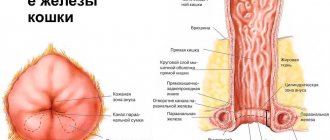If you notice that your cat is bleeding from the vulva, it is understandable that you are worried, as this sign indicates that something is wrong and you are likely facing a health problem.
Cystitis, uterine infections, trauma or tumors may be some of the reasons why your cat is bleeding, but what should we do in these cases? The first step is to immediately contact a veterinary center, since some pathologies that can cause these symptoms can be fatal.
In this article, we will talk about the causes of bleeding in cats, explaining the main reasons why a cat is bleeding and how to treat it. Everything you need to know next, but don't forget: a visit to the vet is essential.
Bloody discharge due to urolithiasis
Urolithiasis (urolithiasis) is a disease accompanied by the formation and deposition of urinary stones or sand in the organs of the urinary system.
Most often, the development of urolithiasis is provoked by an unbalanced diet, when the animal is fed too salty or fatty foods, table scraps, or the pet is kept exclusively on dry food.
Urolithiasis can progress very quickly and often leads to the death of the animal , so if a problem is detected, you should never self-medicate. To minimize your pet's suffering before visiting the veterinarian, you can give him Baralgin M (solution). Dosage: 0.05 mg per 1 kg of animal body weight.
Baralgin M is contraindicated for use if the pet is less than six months old.
Signs of ICD
The development of the disease is indicated by the following symptoms:
- presence of blood in the urine;
- restless behavior of the animal;
- lack of appetite;
- frequent urge to urinate, accompanied by a plaintive meow;
- small amount of urine when urinating;
- apathy.
If you suspect urolithiasis, you should immediately contact a veterinarian. Surgery may be required.
Prevention
As a preventive measure, it is recommended to adjust the animal’s diet. There are some general rules that must be followed when organizing a cat's diet :
- It is necessary to minimize the share of dry industrial food of economy class, because they contain a large amount of salt, which provokes the development of urolithiasis.
- It is recommended to exclude fatty natural products from the diet, including table food.
- Food should contain a minimum amount of sugar, salt, phosphorus and magnesium.
- Your cat should always have fresh water freely available.
The risk of developing the disease can also be reduced by encouraging an active pet lifestyle.
Diagnostics
In order to find out why a cat’s nose is bleeding, the veterinarian prescribes a comprehensive examination of the animal.
Diagnostic methods:
- Tests are performed: general or biochemical blood test, coagulation test, endoscopy, biopsy, cytology, x-ray examination of the nasal cavity;
- A careful visual examination, examination of the nasal as well as oral tracts, mouth, lower nostrils, throat.
- Urinalysis to assess liver function;
- Serological tests are carried out for the presence of fungal diseases, as well as infections caused by ticks;
- Carrying out computed tomography, magnetic resonance imaging;
- Rhinoscopy;
- Blood pressure measurement;
- Surgery for residual diagnosis.
The need for a specific diagnostic method is determined by the veterinarian depending on the complexity of the symptoms. After the diagnosis is established, treatment is prescribed to eliminate the bleeding, as well as the reasons that caused it.
Vaginitis
Vaginitis is an inflammation of the vaginal mucosa.
Many owners mistake vaginitis for estrus due to the fact that cats suffering from this disease are attracted to males. The cause of the disease is most often an unsuccessful mating.
Symptoms of the disease:
- bleeding from the vagina;
- frequent urination;
- swelling of the vulva.
If you suspect vaginitis, it is recommended to wash your cat's vagina with a chamomile solution.
If this bleeding does not stop, you should contact a specialist as soon as possible.
Care, maintenance and treatment of your pet
In order for treatment measures to bring positive results more quickly, owners need to provide the cat with proper care:
- Provide a secluded place for the animal, put a disposable sheet on the bed and change it regularly when it gets dirty.
- The room where the sick cat is located must be warm and free of drafts, and it must be ventilated regularly.
- During treatment, it is forbidden to let your pet go outside; its communication with other pets should be limited.
- The cat must have constant access to drinking water. If the animal refuses to drink or is too weak, you need to give it water yourself using a syringe, after removing the needle.
- During the illness, the animal should receive nutritious and easily digestible food. These can be meat broths, to which chopped meat, fermented milk products, cereals and vegetables are added in small quantities. On the advice of a veterinarian, you can purchase special medicated food so that the animal gains strength faster.
To protect your pet from diseases that lead to bleeding, you must adhere to the following preventive measures:
- If the cat is not intended for breeding, it makes sense to sterilize the pet. This will protect her from many diseases that occur in the genitourinary system. After the procedure, the cat should be regularly shown to the veterinarian for an ultrasound, this will help to better monitor the animal’s health.
- Get all necessary vaccinations and antihelminthic treatment in a timely manner to maintain the body's defenses.
- For mating, choose a healthy male cat; the owners of the male must document this.
- When giving birth to a cat, use sterile consumables and thoroughly treat your hands with antiseptics.
- If any unusual discharge occurs, you should take your cat to the veterinarian as soon as possible.
The measures described above will help not only prevent the development of the disease, but also, if necessary, show the cat to a specialist as soon as possible without wasting time.
Bloody discharge accompanied by a significant deterioration in the animal’s condition is a formidable sign indicating the development of severe pathology. There is no need to try to find the cause on your own, but take the cat to the veterinary clinic as soon as possible for examination and treatment.
Pyometra
Among the most common diseases of cats with bloody discharge is pyometra, a form of purulent endometritis in which pus accumulates in the uterine cavity. The disease is most often provoked by rash actions of the owners themselves, namely:
- abuse of hormonal drugs during estrus;
- uncontrolled mating;
- infection in the vagina during childbirth.
There are two types of pyometra:
- Open form - blood clots come out of the vagina. The cat licks itself frequently, approximately every 15-20 minutes. The animal's temperature rises, the cat often drinks water.
- Closed form - no discharge visible, because blood accumulates in the uterine cavity. Symptoms of the closed form of pyometra: enlarged, tight abdomen, frequent urination, apathy, rapid breathing.
Of these two forms, the second poses the greatest threat to health, because. excessive accumulation of pus in the uterus can lead to the death of the animal.
So what do we see on the outside when internal bleeding occurs?
There are some common signs observed with any bleeding:
- pallor
Constant bleeding can cause your pet to have a low red blood cell count and appear “bleeded out.” You may examine the mucous membranes, including the gums and the conjunctival tissue around the eyes.
When healthy, these tissues have a beautiful pink color. With internal bleeding, these membranes become pale, soft gray to white. You may notice a loss of visible blood vessels in the whites of the eyes, and your cat's beautiful pink nose may turn white.
- tachycardia and rapid breathing
If blood volume decreases, the heart has to beat faster to try to deliver it to all the organs of the body. This can result in a weak, rapid heart rate.
Your cat's normal heart rate should be between 160 and 240 beats per minute.
At the same time, increased work of the lungs occurs, which transfer oxygen to the body tissues. As tissues become starved of oxygen, the brain tells the lungs to breathe faster to deliver oxygen from the inhaled air at a faster rate.
The normal resting respiratory rate for cats is 35 breaths per minute or less.
- collapse (death)
If circulation is impaired to such an extent that blood can no longer be delivered throughout the body, for example to the brain or lungs, then the function of these organs stops.
Call a veterinarian Moscow
+7(495)162-70-70
Discharge after pregnancy
The presence of bloody discharge in a pregnant cat is completely normal when it is presented as transparent, homogeneous, odorless clots.
However, prolonged discharge of purulent-bloody discharge with a greenish tint after birth indicates possible inflammation of the animal’s genital organs.
It often happens that the fetus gets stuck in the cat's womb, or the placenta for some reason does not come out of the uterus, as a result of which the process of rotting begins. In both cases, surgical removal of the foreign object will be required, because prolonged decomposition inside the animal's body can lead to intoxication of the pet.
Sometimes bloody discharge during the postpartum period may be just remnants of the placenta. Usually the placenta is completely expelled from the uterus within 3 hours after birth, and the number of membranes should correspond to the number of kittens. In this case, surgical intervention is not required.
Main symptoms of internal bleeding in cats
Even if your cat is constantly indoors, injuries or illnesses that cause life-threatening internal bleeding can happen in the house - they didn’t calculate the force of the jump, didn’t make it through the closing door, or tipped over together with the reclining chair; curiosity pushes them to swallow toxins and poisons.
All this is accompanied by damage to blood vessels, which are a fragile transport organ for blood circulation in the body.
Large uncontrolled bleeding is life-threatening and is one of the leading causes of death worldwide, but detecting it inside is very difficult.
Did you know that losing just 2 teaspoons of blood per 1 pound of body weight can lead to hypovolemic shock?
Free consultation Moscow
+7(495)162-70-70
After mating
Bloody discharge from the loop may appear in a cat after mating in the event of resorption of the fetus, which can occur at any stage of pregnancy. In most cases, the animal’s body independently copes with the problem , expelling the dead fetuses from the womb, but they can also remain in the uterus for quite a long time.
As a result, fruit rot begins, which can lead to inflammation of the cat’s genitals and blood poisoning. Resorption of the fruit is accompanied by bleeding with pus and mucus. Blood clots have a rather pungent odor.
A possible cause of bleeding after mating can also be an ectopic pregnancy. In this case, urgent assistance from a veterinarian is necessary—delayed surgical intervention can lead to the death of the pet.
Causes
Discharge in cats is usually a symptom or sign of an underlying disease, infection, or other condition. However, there are several common causes of vaginal bleeding in cats.
Estrus
There are still many people who wonder if cats have periods as they tend to compare periods to dogs who bleed during their heat. Dogs and cats may be similar in some ways, but they are different species with big differences, and this is one of them.
Cats don't bleed when they're in heat, so if you've seen your cat soil brown or reddish fluid or have blood when urinating, it means you're dealing with a medical condition. Next, we will talk about the main causes of bleeding in cats.
© shutterstock
Cystitis
This is an inflammation of the bladder that can be caused by a urinary tract infection, bacterial overgrowth, kidney disease, and even injury such as stroke.
When a cat has cystitis, abnormal behavior such as restlessness and nervousness may be observed, especially when using the litter box. We can also hear her meowing, which is her way of complaining about the discomfort caused by her illness. Similarly, in some cases, we can observe that he urinates uncontrollably all over the house as he is unable to properly control urination at the designated place.
Typically in cases of cystitis we observe the presence of fresh blood in the urine and the presence of bacteria under a microscope. This pathology usually has a good prognosis, because cystitis is easily treated with antibiotics, which should be prescribed by a veterinarian.
Pyometra
This is an infection in which pus accumulates inside the uterus. Feverfew in cats is extremely dangerous and can be fatal if not treated promptly. It usually affects cats over 8 years of age who have not been spayed or young cats who have received hormone therapy to stop being in heat.
The disease occurs due to a bacterium that the cat reduces during the estrus phase in which she takes the animal, because at this time it is easier to cross the cervix and take up residence inside. There are two types of feverfew: closed, in which the pus is not expelled and the uterus can burst, causing peritonitis, and open, which, among other things, is characterized by bleeding with pus, dehydration, frequent urination and lethargy.
Miscarriage
If your cat is pregnant and you notice she is bleeding from her vulva, she may be miscarrying. Depending on how far along in pregnancy she is, your cat will be at different risks if she miscarries.
When this occurs during the first few weeks of pregnancy, it may be due to the death of one of the puppies. At this stage, when the fetus is still poorly formed, most cats' bodies will simply absorb the tissue and the chances of complications are low.
If a miscarriage occurs mid-pregnancy, the mother and other puppies may be at risk. At this stage, the miscarriage may be spontaneous due to injury, severe infection of the uterus, or other reasons.
In both cases, a veterinarian must be contacted to perform the necessary tests to ensure the health of the parents and the unarrived puppies. Most likely, a specialist will need an ultrasound or x-ray to assess the condition of the pregnancy.
Birth
When it's time for a cat to give birth, bleeding from the vulva is normal. If you have been tracking your pregnancy, it will be easy to determine if you are close to your due date. Remember that this can happen on certain days and even a week in advance.
Before giving birth, not only will the cat have bleeding from the vulva, but you will also see that she becomes more restless, she will look for a "nest" for protection and expel mucus, which is a mucus plug indicating that labor has already occurred.
Stones in the kidneys
Kidney stones are a frustrating health problem for felines. They cause painful urination and are very dangerous. One of the symptoms of its presence is bloody discharge, as a tiny stone can become “stuck” in the urinary tract, which causes pain when urinating.
The appearance of kidney stones has several causes, but one of the most common is diet. A diet high in saturated fat and flour will cause these types of problems, which is why it is so important to provide our cats with quality food.
© shutterstock
Injury
This name is given to shocks that a cat may be subjected to and which have negative consequences for its body. They can occur after a fight with another cat or after a fall and cause organ damage, leading to bleeding. When this happens, it is common for your cat to bleed from the vulva and other parts of the body. In some cases, you may find bruise-like marks on your body, while in others you may not.
Injuries are very dangerous, as they are associated with possible damage to vital organs, as well as internal effusions. If you suspect your cat has suffered such impacts, do not hesitate to go to the vet immediately.
Tumors
A tumor is an abnormal growth of tissue anywhere in the body. This may be in areas that affect the kidneys, reproductive system or urination, in which case your cat will have bloody discharge. It is important to note that most tumors, benign or malignant, are not visible at first glance, so only a veterinary examination with appropriate testing will help determine whether this is the cause of the bleeding and the nature of the tumor.
Discharge from the urethra: treatment
The treatment method in this case directly depends on the cause that caused such a phenomenon as pathological discharge from the urethra. It is important to understand that self-treatment can cause complications and is therefore unacceptable. Discharge can occur due to the penetration of various types of pathogens, which must be combated using different methods. Most often, drug therapy involves the use of antibiotics, but their selection should be carried out on an individual basis. As a rule, the following means are used:
| Group | When to use | Name |
| Antibacterial | STD | "Azithromycin", "Amoxiclav" |
| Uroseptics | Urethritis | A solution of chlorhexidine and collargol |
| Sulfanilamide | When bacteria that cause inflammation are detected | "Doxycycline" |
| Antimicrobial | Trichomoniasis | "Metronidazole" |
In addition, patients are recommended to wash their genitals with decoctions of knotweed, chamomile, calendula or special antiseptic solutions. Warming applications and electrophoresis give good results.











